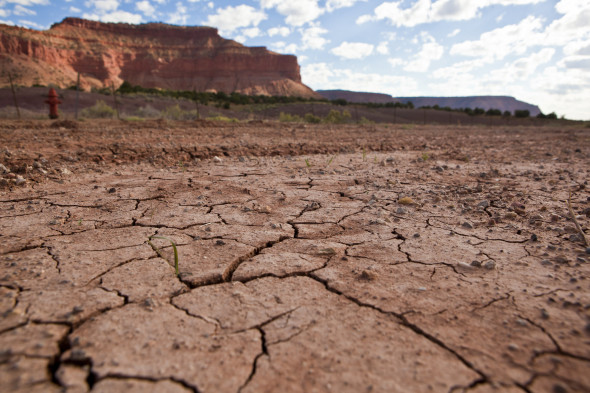TakePart | August 29, 2014
 With the American West losing an estimated 63 trillion gallons of groundwater over the past 18 months, it’s hard to imagine that the drought could get any worse.
With the American West losing an estimated 63 trillion gallons of groundwater over the past 18 months, it’s hard to imagine that the drought could get any worse.
But it just might.
A new study estimates that the possibility of a decade-long drought hitting the Southwest sometime this century could be as high as 90 percent. And there’s as much as a 50 percent chance of a mega-drought that lasts for 35 years or more, according to Toby Ault, a professor of earth and atmospheric sciences at Cornell University.
“This is only the beginning,” said Ault, whose research will be published next month in the Journal of Climate. “The further south you go, the drier the average conditions really are, and the risk is greater.”
It’s the first research that quantifies the risk of drought from reduced precipitation and drier conditions caused by climate change. Scientists conducted their analysis by incorporating historical data of past mega-droughts in the Southwest—such as the series of long-running droughts that struck the region between 900 and 1400—into computer models of contemporary climate observations.
The drought forecast in the Southwest—which the researchers define as Central to Southern California, Nevada, Southern Arizona, Southern Utah, New Mexico, Southern Colorado, and Western Texas—compares starkly with predictions for the northern states. Ault’s computer models indicate that Washington, Montana, and Idaho, for instance, face a decreased risk for drought over this century.
“Dry regions get drier, wet regions get wetter, and places on the edge are uncertain,” Ault said.
Making global predictions about drought is harder as less data is available for many regions outside the United States. “But even so, we saw that the Southwestern U.S. looks like it’s exposed to risks that are comparable to other parts of the world, such as parts of Africa, Northern Mexico, and parts of Brazil,” said Ault.
Researchers at Scripps Institute of Oceanography recently found that the earth’s surface in the West has risen 0.16 inches over the last year and a half as a result of losing 63 trillion gallons of water. Another report estimates that water levels in California’s three largest reservoirs have fallen 70 percent.
So what would a drought prolonged for 35 years or longer look like?
“Take the current drought and double it,” Ault said. “In Arizona, there’s been a drought that’s gone on and off for the last 10 years. Doubling that, it looks very challenging.”
Next up for Ault is to calculate how much snowpack and groundwater would be lost in a mega-drought. He also plans to determine how much water the Colorado River would lose during a decades-long drought.
Though his predictions focus on the risk of drought brought on by drier conditions from climate change, Ault says he’s still not sure if the West’s current drought is a result of global warming.
But regardless of the relationship, he emphasizes that people should pay attention to how drought is affecting the region.
“It’s a glimpse and preview of what we expect to happen from climate change—and a picture and window into the future,” he said.
Photo of drought in Utah by Anthony Quintano via flickr/Creative Commons